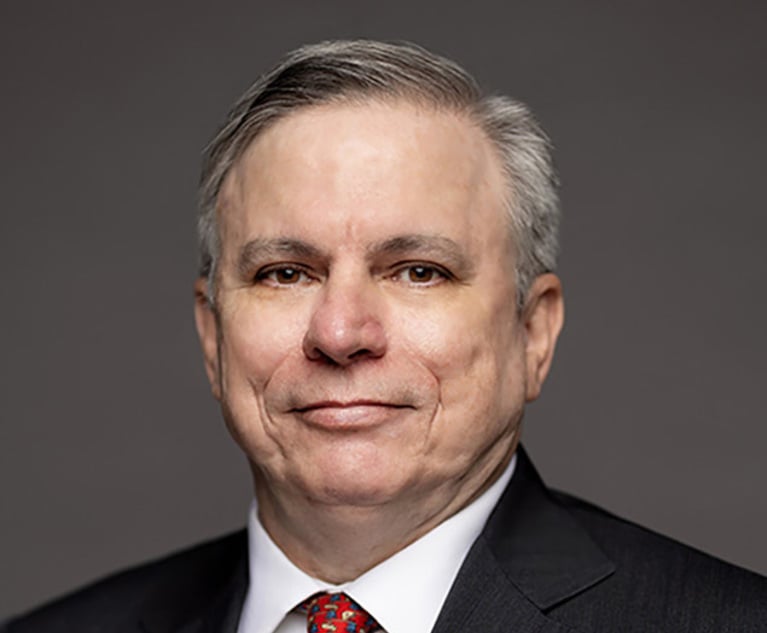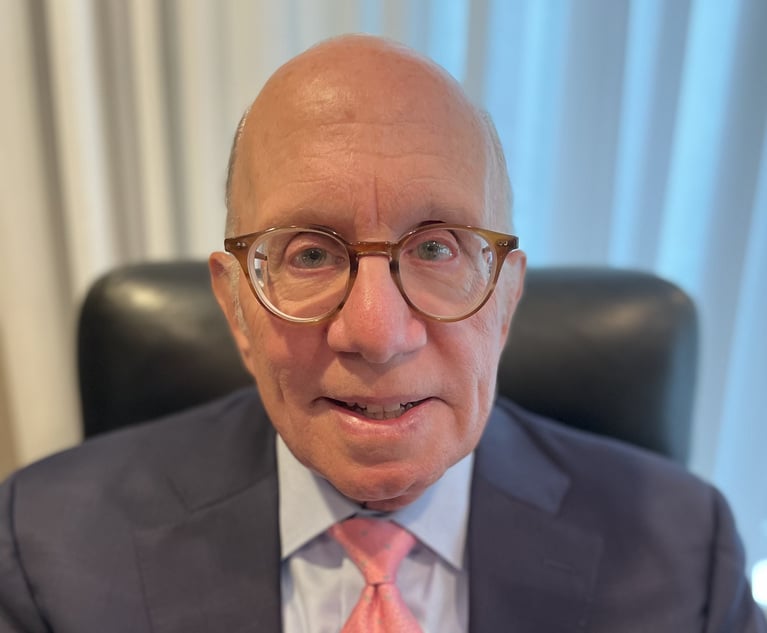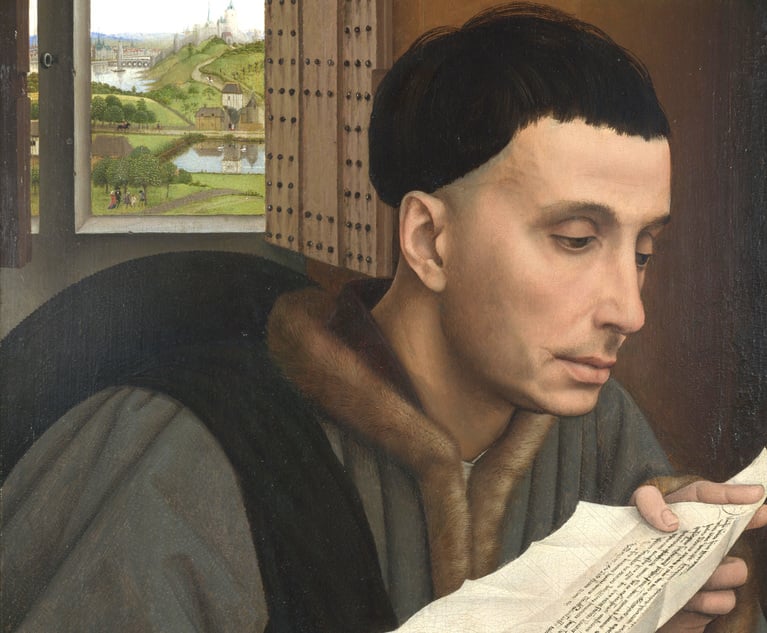 Photo Credit: Shutterstock.com
Photo Credit: Shutterstock.comWhimsical Reflections From Expert Witness 'Rocking Chairs': Part 2
This essay is a "step back" from the author's tenure in different roles at the Court of Appeals spanning the last quarter of the last century. The reminiscences recounted here, however, are from his more recent endeavors as a witness in various cases.
February 06, 2020 at 11:00 AM
8 minute read
This is part two of a four-part article describing experiences from "the other side of the bench."
Life in turbulent times is more tolerable when softened through whimsical twinkling eyes taking a look back. In that spirit, this exertion is a "step back" from my tenure in different roles at the Court of Appeals spanning the last quarter of the last century (1975 to 2000). The reminiscences, however, are principally of more recent vintage (2005-2017) that emanate after my judicial and academic careers. During the "retirement" stage from affiliated postings, I accepted a few engagements that landed me in witness chairs. Part 1 recounted my experience at the Tortola High Court of Justice, British Virgin Islands Commercial Division in the Eastern Caribbean. We continue here with Part 2.
London, England: The High Court of Justice, Queen's Bench Commercial Division. This New York law expert witness engagement in another breach of contract dispute was also governed by a standard New York law clause. The venue was the regular commercial courts of London, England. The modern building and high-tech courtroom (no "Old Bailey," this place) were very impressive, with lots of bells and whistles of modern technology—very different from laid-back Island of Tortola.
My report, other expert reports, and multiple volumes of a huge record were set in place around the witness chair. They virtually surrounded any witness, as though plopped down within a large tent. The bound volumes and the various computer screens were intimidating. Similar set-ups were arranged throughout the cavernous courtroom for the many counsel, and for the presiding jurist up on his bench. The pointillist busyness of the scene exuded a madly Hieronymus Bosch painting aura, at once hilarious, yet scary, too. The massive array of hard-copy paper in thick binders piled high all about put the lie to the "paperless age," promised by the gurus of high-tech.
The witness chair was set up with three angled terminals, virtually a Wall St. trading floor station—or a Starship Enterprise module. One projected the question and answer in real-time viewable rolling transcription, as it unfolded; a second, showed any record reference being used within the moment of the posed-question exchange; and a third, impressively pulled up immediately any outside research case or authority reference. Mirabile Dictu! In one sense, these amazing and dizzying, too, technical aids were supposed to be helpful to all including the witness. Viewed otherwise, they were a virtual new world for a retired fellow accustomed to a more deliberative pace of finger-pulled dusty bound volumes with earmarked pages.
Some of this set-up made me think nostalgically of the virtual gas lamps era of my mentor judge (The Honorable Marcus G. Christ, Presiding Justice of the Appellate Division, Second Judicial Department located in Brooklyn) with whom I had the privilege of clerking in the 1960s. He wore a green eye-shade on the bench to protect his eyes from glare; and we shared a love of the touch of bound Official Reports books removed from a shelf.
To say nothing of the memory of my early years of my Chief Clerkship at the Court of Appeals, with virtually quill pens and heavy ledger books as the court's modus operandi system of case management. Computers had not arrived yet in that not-so-far-back period of 1975. It is practically the blink of an eye of time back to the future to a recent landing, as it were, onto a futuristic British courtroom set.
As usual, once the trial preliminaries were attended to and my expert report was summarily placed in evidence, the down-to-business cross-examination started forthwith. The preparation at the London barrister's offices in the days before the trial had been intense. Shortly into my cross-examination, my nerves relaxed as I got accustomed to the give-and-take and the neck-snapping logistics necessary to parlay my scans of the three screens, while paying attention to the questions and body-language of the inquisitor.
Somewhat to my surprise, a young barrister took up the role of supplementing his more experienced colleague's initial effort to demolish my report. Too smug in attitude, he first walked me through various materials. He had my head spinning as I tried to follow him, while he juggled cases and me with his directions to the various terminals to which he kept adverting. I sensed he was relishing the edge his youthful tech facility gave him over the mature Luddite he had in the witness chair—that is, until he blundered into a surprisingly opportunistic return jab from me.
He blithely kept trying to trip me up with federal district court cases that were not part of my report—referencing the lowest-level federal trial tribunals that are required to apply New York Court of Appeals law in such cases. He mistakenly treated his citations, however, as though they were superior binding authority, insinuating a problem with my unfamiliarity. This common bias—something that occurs among many American lawyers, too, and often among elite law faculties—was leading him down his self-made blind alley. At first, I chose not to remind him of the controlling principle and protocol that New State jurisprudence governs under these contract clauses—a foundational precept explained fully in the expert reports.
He finally sprung his trap but on himself just when he thought he had me in a box. He proffered an unpublished opinion from a federal district court and insisted that I explain how it could be reconciled since it was opposite to the cases cited in my report. When I indicated I did not know the case to which he was referring, he hit a button that popped it up into my face on one of the terminals. After allowing me a few moments to peruse it, he resumed a badgering demand for an explanation.
Among other things, I had noticed a legend at the top that the case was an opinion but held that detail in reserve, noting instead that I disagreed with the case and that it was not binding in any event under the New York state law whose authorities I had cited. I explained that the federal district court had fundamentally erred because it failed to follow the authoritative New York cases. The young man was dismayed and foolishly pressed me to explain further.
My "further explanation" was a simple primer on the respective roles of the state and federal courts, lowering the coup de grace that an unpublished opinion by a trial-level federal district court, even under that court's own rules, was not binding nor was it even permissible to be cited. He was crestfallen, as I caught a glimpse of an unamused trial judge. One of the defense table senior barristers rose to the embarrassed rescue. He wanly asked the court if he could resume the cross-examination from his young colleague. The court drolly acquiesced, noting that he hoped the instant line of inquiry would be dropped, as it was plainly of no help to the court in appreciating the nuances of New York substantive law and procedures. The senior cross-examiner then put a few perfunctory questions to me, and I was excused, with the thanks of the court for my assistance.
I was still in the courtroom after my testimony to notice a not-unrelated additional lapse. The opposing expert witness, a retired federal judge, ill-befittingly devalued the credit-worthiness of the New York state court authorities, while elevating, as he saw it, the more significant weight and credentials of his federal court proffer. This Article III haughtiness reflected that irritating and unfounded bias of the academy and many practicing lawyers concerning the relative quality of state courts compared to the federal bench. Even worse, the characterization, potentially at least, skewed the correct understanding of the foreign tribunal concerning something on which each expert was obliged to provide accurate guidance—not institutional self-promotion.
The exchange with the young barrister and then listening with disappointment to the opposite expert witness taught me some lessons sitting in that in a courtroom of the shared Anglo heritage from whence American common law sprung several centuries ago. The barrister had probably missed some fundamental lessons in his Evidence and Trial Practice courses at the Inns of Court about effective cross-examination, whether in British or American tribunals. Moreover, his preparation for the particular trial failed to pay heed to the pertinent nuances of American Federalism jurisprudence because he flat-out missed the fundamental protocols of practice that were clearly laid out in my report. Instead, he engaged in sophomoric Perry Mason TV-like entertainment tricks. That might have been forgiven because he was immature and inexperienced. Not so, a retired federal judge who should have known better, testifying in a foreign jurisdiction where the sibling state jurisprudence was credited with more respect by the foreign presiding jurist than by an American judge.
Joseph W. Bellacosa is a retired judge of the New York Court of Appeals.
Other articles in this series:
This content has been archived. It is available through our partners, LexisNexis® and Bloomberg Law.
To view this content, please continue to their sites.
Not a Lexis Subscriber?
Subscribe Now
Not a Bloomberg Law Subscriber?
Subscribe Now
NOT FOR REPRINT
© 2024 ALM Global, LLC, All Rights Reserved. Request academic re-use from www.copyright.com. All other uses, submit a request to [email protected]. For more information visit Asset & Logo Licensing.
You Might Like
View All
Why Is It Becoming More Difficult for Businesses to Mandate Arbitration of Employment Disputes?
6 minute read
Trending Stories
- 1Gibson Dunn Sued By Crypto Client After Lateral Hire Causes Conflict of Interest
- 2Trump's Solicitor General Expected to 'Flip' Prelogar's Positions at Supreme Court
- 3Pharmacy Lawyers See Promise in NY Regulator's Curbs on PBM Industry
- 4Outgoing USPTO Director Kathi Vidal: ‘We All Want the Country to Be in a Better Place’
- 5Supreme Court Will Review Constitutionality Of FCC's Universal Service Fund
Who Got The Work
Michael G. Bongiorno, Andrew Scott Dulberg and Elizabeth E. Driscoll from Wilmer Cutler Pickering Hale and Dorr have stepped in to represent Symbotic Inc., an A.I.-enabled technology platform that focuses on increasing supply chain efficiency, and other defendants in a pending shareholder derivative lawsuit. The case, filed Oct. 2 in Massachusetts District Court by the Brown Law Firm on behalf of Stephen Austen, accuses certain officers and directors of misleading investors in regard to Symbotic's potential for margin growth by failing to disclose that the company was not equipped to timely deploy its systems or manage expenses through project delays. The case, assigned to U.S. District Judge Nathaniel M. Gorton, is 1:24-cv-12522, Austen v. Cohen et al.
Who Got The Work
Edmund Polubinski and Marie Killmond of Davis Polk & Wardwell have entered appearances for data platform software development company MongoDB and other defendants in a pending shareholder derivative lawsuit. The action, filed Oct. 7 in New York Southern District Court by the Brown Law Firm, accuses the company's directors and/or officers of falsely expressing confidence in the company’s restructuring of its sales incentive plan and downplaying the severity of decreases in its upfront commitments. The case is 1:24-cv-07594, Roy v. Ittycheria et al.
Who Got The Work
Amy O. Bruchs and Kurt F. Ellison of Michael Best & Friedrich have entered appearances for Epic Systems Corp. in a pending employment discrimination lawsuit. The suit was filed Sept. 7 in Wisconsin Western District Court by Levine Eisberner LLC and Siri & Glimstad on behalf of a project manager who claims that he was wrongfully terminated after applying for a religious exemption to the defendant's COVID-19 vaccine mandate. The case, assigned to U.S. Magistrate Judge Anita Marie Boor, is 3:24-cv-00630, Secker, Nathan v. Epic Systems Corporation.
Who Got The Work
David X. Sullivan, Thomas J. Finn and Gregory A. Hall from McCarter & English have entered appearances for Sunrun Installation Services in a pending civil rights lawsuit. The complaint was filed Sept. 4 in Connecticut District Court by attorney Robert M. Berke on behalf of former employee George Edward Steins, who was arrested and charged with employing an unregistered home improvement salesperson. The complaint alleges that had Sunrun informed the Connecticut Department of Consumer Protection that the plaintiff's employment had ended in 2017 and that he no longer held Sunrun's home improvement contractor license, he would not have been hit with charges, which were dismissed in May 2024. The case, assigned to U.S. District Judge Jeffrey A. Meyer, is 3:24-cv-01423, Steins v. Sunrun, Inc. et al.
Who Got The Work
Greenberg Traurig shareholder Joshua L. Raskin has entered an appearance for boohoo.com UK Ltd. in a pending patent infringement lawsuit. The suit, filed Sept. 3 in Texas Eastern District Court by Rozier Hardt McDonough on behalf of Alto Dynamics, asserts five patents related to an online shopping platform. The case, assigned to U.S. District Judge Rodney Gilstrap, is 2:24-cv-00719, Alto Dynamics, LLC v. boohoo.com UK Limited.
Featured Firms
Law Offices of Gary Martin Hays & Associates, P.C.
(470) 294-1674
Law Offices of Mark E. Salomone
(857) 444-6468
Smith & Hassler
(713) 739-1250








